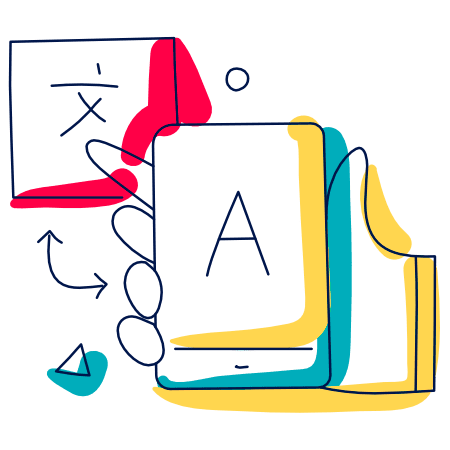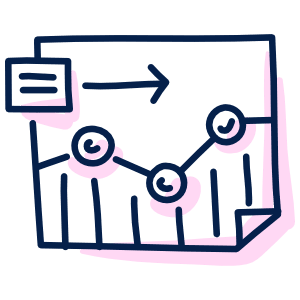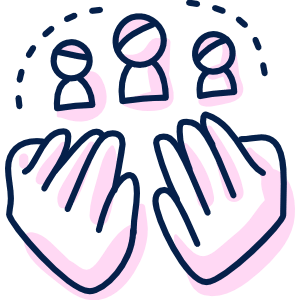Full-service translation
Transly Translation Agency is a full-service translation agency. We do our best each day to meet your translation and content creation needs. That is why, in addition to translation services, editing, content creation, and website translation, we also offer additional services. These are software localisation, subtitle translation, subtitling, voice-over, dubbing, translation consultation, translation memory creation, translation quality assessment, layout, design, and much more besides. Our services also include interpreting and consecutive interpreting.

Why choose Transly?
How to place an order?
To place an order, send us an email or fill out the enquiry form with the following information:
- what services you are interested in;
- which languages you need the service in;
- what the deadline for the job is.
Please include any additional information or a file when submitting your request so that we can analyse it and get back to you.
We will get back to you with a quote within an hour.

Transly Translation Agency’s advantages
Excellent linguistic services
We will do our utmost to ensure that the linguistic service you ordered from us meets your expectations. Ensuring that the result meets your expectations is our ultimate objective. Transly Translation Agency is certified to ISO 17100:2015 which means that we comply with the international translation services standard. We respond quickly, always strive to find the best solutions for you and help you tackle any linguistic challenges you may face.

Linguistic service at the best price
Transly offers linguistic services with the best price-to-quality ratio. Our translation projects are carried out using the most modern technologies available and involve both a translator with a master’s degree and a professional editor. Thanks to smart software solutions and continuously evolving technology, we can offer a very competitive price. We always do our utmost to make you an offer that best suits your needs.

Swift process
We work fast. Thanks to Transly’s excellent technical capabilities, skilled team, and smooth processes, our working process is also faster. We always do our utmost to get back to you as soon as possible and the same applies to the preparation of price quotes. If necessary, we can speed things up even more by having several linguists working on one project simultaneously. Rapidly evolving technology helps accelerate our work process. As a result, our work is swift, efficient, and flexible. Therefore, we can safely say that Transly is one of the fastest linguistic service providers in the field.

Smooth process
We are here to make the process as smooth and convenient for you as possible. Thanks to our extensive knowledge and experience, we have been able to develop solutions that enable us to manage projects while also making use of a central workflow system. We know that project management entails much more than just administration. Having a streamlined workflow is essential to guarantee a stress-free ordering experience, transparent budget, and language services that are completed in due time. For this purpose, we have minimised all time-consuming standard procedures. This way you can be sure that both the budget and the deadline for the service will meet your high expectations.

Confidentiality guaranteed
We guarantee the confidentiality of all texts. Digital safety, data protection and confidentiality are aspects which we take very seriously in our work. The contract for language services contains a confidentiality agreement. If necessary, it is also possible to conclude a separate confidentiality contract. The use of specific software and a secure storage server both help reduce the risk of data leaks. The risk of data leaks and emails reaching the wrong recipient is further reduced by the use of a two-factor authentication email application. Additionally, real-time backup is integrated into our linguistic service process, ensuring that your data is in safe hands with us.

A one-stop shop for all your language needs
We want your co-operation with us to be as convenient as possible. We will do our best to accommodate all your translation, editing and content creation wishes as well as those related to these services. Therefore, we also offer a search engine optimisation service for translated websites and a localisation service for online stores. Our services also include software localisation, subtitle translation, subtitling, voice-over, dubbing, translation consultation, translation memory creation, translation quality assessment, and much more besides. We also provide interpreting and consecutive interpreting services. In addition, we are happy to offer layout, design and printing services for the texts. This all ensures that you can easily and conveniently find all necessary language editing related services in one place.

Transly Translation Agency offers professional lingiustic services and saves you both time and money.
Our competent project managers answer enquiries quickly and provide good advice
Külli
Külli is the Head of Translation at Transly Translation Agency. She has been working as a translator for more than 15 years and has studied translation at Tallinn University. Külli is a perfectionist who is never satisfied with anything less than the optimal result. Her unique ability is her fast-reading skills. She also has extremely good technical acuity and an unerring ability to anticipate upcoming trends.

Shane
Our conscientious sales manager, Shane, does his best to exceed customer expectations. Shane received a Bachelor of Commerce degree at McMaster University in Canada, with a focus in Marketing. In addition to English, he also speaks Spanish and fluent Estonian. He listens to the needs of clients and always finds the solutions that suits them best. He responds to emails at lightning speed and always gives good advice, making working with Transly a breeze. His creative thinking and willingness to help bring customers back to us again and again.

Which additional service do you need?
Transcription
Transcription is the process of converting audio and video content into written form. The final product of this process is called a transcription. Where necessary, we can transcribe an audio file before translating or editing. Additionally, we offer the transcription of audio and video files for R&D.

Subtitling
Subtitle translation is one way of making movies in foreign languages accessible to the local audience. Subtitles appear as characters speak and make speech in foreign languages accessible. In order to create subtitles, we have to transcribe the video file, ie we convert spoken words into writing. Once this is complete, we translate the subtitles and add them to the video.

Voice-over
Voice-over consists of a simultaneous interpreter or an actor speaking over a radio or television clip or video in order to provide a translation or add comments or explanations, while retaining the original voices and/or texts. In order to create voice-overs, we first have to carry out transcription or create the text. Where necessary, we can also translate the text that is being used in the voice-over. You can choose the voice that best suits your needs from our selection of voice samples. Once you have done that, the chosen voice artist will record the voice-over in Transly’s studio.

Dubbing
Dubbing, on the other hand, is the replacement of original voices and/or texts in an audio(visual) production with the voices of consecutive interpreters, actors or presenters. Dubbing is used all over the world. If the dubbing is constructed professionally then each character has their own voice and the lip movements correspond to dubbed speech quite nicely. In the case of dubbing, we will transcribe the audio or video file. We will also send you a selection of voice samples so that you can choose the voice that best suits your needs. Once you have done that, the chosen voice artist will record the lines in Transly’s studio.

Translation consulting
We offer you support in all matters related to translation and content creation. If necessary, we provide suggestions on adjusting, updating or creating terminology. We update and manage term bases. We provide assistance in choosing the most appropriate translation software. We support our customers in all translation software-related matters and, if needed, can provide advice and assistance in implementing translation software.

Creating a translation memory
To create a translation memory, we group together all your existing translations. The translations are then used to create a translation memory. If necessary, we will also carry out quality assessments for the previous translations and harmonise the terminology. Depending on the volume of the translations, a file will be created containing all the text segments translated so far. If any future translations you order contain repeat segments, this will allow you to save money on already translated parts, as the translator will not need to retranslate previously translated texts.

Translation quality assessment
Translation quality assessment gives you an overview of the quality of existing translations. This is often a useful solution when you have doubts about the quality of a translation or need an objective evaluation of a finished foreign-language translation. Translation quality assessment allows you to see the types of error the text contains along with their frequency, and provides you our comprehensive independent evaluation of the translation.

Translation layout and design
Layout may be useful if you need the text back in exactly the same shape and size in which you submitted it for translation. We can redesign all graphs, figures and diagrams in the translated file. Layout is particularly important for providing a complete translation service in the case of user manuals, catalogues, product sheets, infographics, reports, books and other major texts.

Entrust us to solve your linguistic problems. Transly Translation Agency provides a fast and quality service.
Frequently asked questions about additional services
What is software localisation?
Localisation is the comprehensive adaptation of a translation to the target market. In addition to the standard translation process, localisation can also include the creation of a term base, the development of a style guide, the adaptation of graphics to the target market, testing, and more.
Software localisation is the translation and customisation of a computer program or mobile application. At its core, it is most similar in nature to the localisation of multilingual websites. Software localisation takes into account the preferences, needs and habits of users in another country. Software localisation is performed by committed translators for whom the target language is their first language and who are fully experienced in solving IT-related challenges.
What is translation consultation?
We offer you support in all matters related to translation and content creation. If necessary, we provide suggestions on adjusting, updating or creating terminology. We update and manage term bases. We provide assistance in choosing the most appropriate translation software. We support our customers in all translation software-related matters and, if needed, can provide advice and assistance in implementing translation software.
These and many other activities are grouped under the common denominator “translation consultation”. We will ensure that you receive a friendly and professional service and comprehensive answers from our responsive and competent project managers to all your questions related to language, translation, and content creation.
Why create a translation memory?
Translation memory creation is a service that can help you save a significant amount of money on translations. To create a translation memory, we group together all the translations you have ordered from us over the years. For this, we need both source and target language files. The translations are then used to create a translation memory. If necessary, we can also check the quality of your previous translations and make corrections to ensure terminological consistency. Depending on the volume of the translations, a file will be created containing all the text segments translated so far. If any future translations you order contain repeat segments, this will allow you to save money on already translated parts, as the translator will not need to retranslate previously translated texts. If you need many translations on a regular basis and the texts have numerous repetitions, as is often the case with user manuals, product descriptions and websites, creating a translation memory is a useful service.
When should you order translation quality assessment?
Translation quality assessment gives you an overview of the quality of existing translations. This is often a useful solution when you have doubts about the quality of a translation or need an objective evaluation of a finished foreign-language translation. Translation quality assessment involves identifying translation errors by subjecting texts to random or full checks. After the assessment is conducted, you will receive an overview of the errors in the text. This allows you to see the types of error the text contains and their frequency, along with providing a comprehensive independent evaluation of the translation.
Which interpreting service should you order?
Interpreting is divided into the following categories: simultaneous interpreting, whispered interpreting and consecutive interpreting. Simultaneous interpreting means interpreting the text while the speaker is speaking, and is primarily used for conferences (conference interpreting), official meetings, and gatherings. Simultaneous interpreting requires two interpreters per language combination, who work in an interpreting booth. Simultaneous interpreting can be delivered in several languages simultaneously.
Whispered interpreting, as the name implies, is a sub-type of simultaneous interpreting in which the interpreter translates the speaker’s words for the listener in a quiet and unobtrusive voice. Whispered interpreting is more suitable for smaller gatherings. In the case of consecutive interpreting, the interpreter sits among the participants and takes notes while listening to the speaker. Every two to three sentences, when the speaker pauses, the interpreter presents the spoken message in the target language. Additionally, we provide another form of consecutive interpreting, in which the interpreter presents the translation once the speaker has finished speaking entirely.
What are voice-over and dubbing?
Voice-over consists of a simultaneous interpreter or an actor speaking over a radio or television clip or video in order to provide a translation or add comments or explanations, while retaining the original voices and/or texts. Dubbing, on the other hand, is the replacement original voices and/or texts in an audio(visual) production with the voices of consecutive interpreters, actors or presenters.
However, in translating audio and video materials, we do the opposite, by transcribing the audio or video file, ie put a spoken text into writing. If you send us an email with a short description of what kind of voice you need (sex, age, specific features), we will send you a selection of voice samples. Once you have done that, the chosen voice artist will carry out the dubbing or voice-over.
What is layout?
We also provide a layout service. Layout consists of creating a design for a book, report, magazine, information material or other text. Layout, not to be confused with design, means the placement and formatting of a text. Layout may be useful if you need the text back in the exactly the same shape and size in which you submitted it for translation. We can redesign all graphs, figures and diagrams in the translated file. Layout is particularly important for providing a complete translation service in the case of user manuals, catalogues, product sheets, infographics, reports, books and other major texts.
What is design?
We also provide a design service. Design is the creation of design elements. The term “design” is used if the amount of text in a file is not significantly larger than the amount of design elements and if it is important to create attractive graphics for the material.
Design is generally combined with content creation. We develop original designs for advertising texts, articles, leaflets and even menus to improve their legibility and visual appeal.
Where can you order printed materials from?
We can also be of assistance if, after translation, you also wish to have the translated materials printed. We have a partner network of printers through whom we can provide high-quality printed materials at affordable rates. We communicate directly with the printers, thus cutting out the middlemen. Thanks to our long-term cooperation, we can offer you a competitive price for a wide range of printed materials. However, as printing information materials, books, magazines, advertising materials or brochures is not our primary service, we can only offer you our printing service together with our translation, editing or content creation services.
Why should you prefer a full-service translation agency?
We offer a full-service translation and content creation at the request of our customers, ie you. We want to be your trusted partner for translation, language editing, content creation and even multilingual digital marketing (foreign-language SEO). We hope that the opportunity to order all language services from one agency will help guarantee that your translations, written communications and marketing texts are flawless. Thanks to the use of translation memories, we can offer translation services to regular partners at an especially attractive price. We offer you a dedicated team, which means that your contact person is always the same project manager and your texts are always handled by a translator, an editor and a copywriter specifically assigned to your projects. We take a personal approach to your needs and always do our best to provide you with the service you need.












